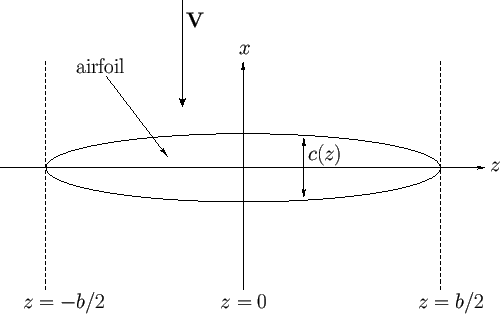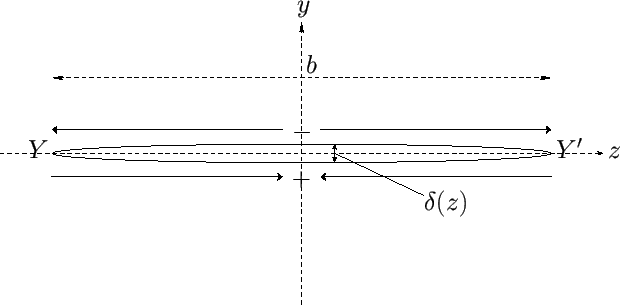 |
Suppose that air circulation is set up around the wing parallel to the ![]() -
-![]() plane in such a manner as to produce an upward lift. It follows that
the average pressure on the lower surface of the wing must exceed that on its upper surface. Consider Figure 9.9, which shows a
back view of the airfoil shown in Figure 9.8. As we go from the median plane (
plane in such a manner as to produce an upward lift. It follows that
the average pressure on the lower surface of the wing must exceed that on its upper surface. Consider Figure 9.9, which shows a
back view of the airfoil shown in Figure 9.8. As we go from the median plane (![]() ) to a wing tip,
) to a wing tip, ![]() , whether along the upper
or the lower surface of the wing, we must arrive at the same pressure at
, whether along the upper
or the lower surface of the wing, we must arrive at the same pressure at ![]() . It follows that there is a drop in pressure as we move outward,
away from the median plane, along the wing's bottom surface, and a further drop in pressure as we move inward, toward the median plane,
along the upper surface. Because air is pushed in the direction of decreasing pressure, it follows that the air that impinges on the
wing's leading edge, and then passes over its upper surface, deviates sideways toward the median plane. Likewise, the
air that passes over the wing's lower surface deviates sideways away from the median plane. (See Figure 9.8.)
. It follows that there is a drop in pressure as we move outward,
away from the median plane, along the wing's bottom surface, and a further drop in pressure as we move inward, toward the median plane,
along the upper surface. Because air is pushed in the direction of decreasing pressure, it follows that the air that impinges on the
wing's leading edge, and then passes over its upper surface, deviates sideways toward the median plane. Likewise, the
air that passes over the wing's lower surface deviates sideways away from the median plane. (See Figure 9.8.)
 |
The air that leaves the trailing edge of the wing at some point ![]() must have impinged on the leading edge at the different
points
must have impinged on the leading edge at the different
points ![]() and
and ![]() , depending on whether it travelled over the wing's upper or lower surfaces, respectively. Moreover, air that travels to
, depending on whether it travelled over the wing's upper or lower surfaces, respectively. Moreover, air that travels to ![]() via the
wing's upper surface acquires a small sideways velocity directed towards the median plane, whereas that which travels to
via the
wing's upper surface acquires a small sideways velocity directed towards the median plane, whereas that which travels to ![]() via the
lower surface acquires a small sideways velocity directed away from the median plane. On the other hand, the air speed at
via the
lower surface acquires a small sideways velocity directed away from the median plane. On the other hand, the air speed at ![]() must be the same,
irrespective of whether the air arrives from the wing's upper or lower surface, because the pressure (which, according to Bernoulli's theorem, depends on the air speed) must be continuous at
must be the same,
irrespective of whether the air arrives from the wing's upper or lower surface, because the pressure (which, according to Bernoulli's theorem, depends on the air speed) must be continuous at ![]() . Thus, we conclude that there is a discontinuity in the direction of the air emitted
by the trailing edge of a wing. This implies that the interface,
. Thus, we conclude that there is a discontinuity in the direction of the air emitted
by the trailing edge of a wing. This implies that the interface,
![]() , between the two streams of air that travel over the upper and lower
surfaces of the wing is a vortex sheet. (See Section 9.5.) Of course, this vortex sheet constitutes the wake that trails behind the airfoil. Moreover, we would
generally expect the wake to be convected by the incident wind.
It follows that the vorticity per unit length in the wake can be written
, between the two streams of air that travel over the upper and lower
surfaces of the wing is a vortex sheet. (See Section 9.5.) Of course, this vortex sheet constitutes the wake that trails behind the airfoil. Moreover, we would
generally expect the wake to be convected by the incident wind.
It follows that the vorticity per unit length in the wake can be written
| (9.63) |
 |
As we saw previously, the boundary layer that covers the airfoil is such that the tangential velocity ![]() just outside the
layer is sharply reduced to zero at the airfoil surface. Actually, the nature of the substance enclosed by the surface is
irrelevant to our argument, and nothing is changed in our analysis if we suppose that this region contains air at rest. Thus, we can replace
the airfoil by air at rest, and the boundary layer by a vortex sheet,
just outside the
layer is sharply reduced to zero at the airfoil surface. Actually, the nature of the substance enclosed by the surface is
irrelevant to our argument, and nothing is changed in our analysis if we suppose that this region contains air at rest. Thus, we can replace
the airfoil by air at rest, and the boundary layer by a vortex sheet, ![]() , with a vortex intensity per unit length
, with a vortex intensity per unit length
![]()
![]() that is determined by the velocity
discontinuity
that is determined by the velocity
discontinuity ![]() between the air just outside the boundary layer and that at rest in the region where the airfoil was previously located. In fact, Equation (9.56) yields
between the air just outside the boundary layer and that at rest in the region where the airfoil was previously located. In fact, Equation (9.56) yields
We conclude that a stationary airfoil situated in a uniform wind of constant velocity is equivalent to a vortex sheet ![]() , located at the airfoil surface, and a wake
, located at the airfoil surface, and a wake
![]() that trails behind the airfoil, the airfoil itself being replaced by air at rest. The vorticity within
that trails behind the airfoil, the airfoil itself being replaced by air at rest. The vorticity within ![]() is largely parallel to the
is largely parallel to the ![]() -axis [because
-axis [because ![]() and
and ![]() are both essentially parallel to the
are both essentially parallel to the ![]() -
-![]() plane--see Equation (9.64)], whereas that
in
plane--see Equation (9.64)], whereas that
in
![]() is parallel to the incident wind direction. (See Figure 9.11.) The vortex filaments within
is parallel to the incident wind direction. (See Figure 9.11.) The vortex filaments within ![]() are generally termed bound filaments (because
they cannot move off the airfoil surface). Conversely, the vortex filaments within
are generally termed bound filaments (because
they cannot move off the airfoil surface). Conversely, the vortex filaments within
![]() are generally termed free filaments.
The air velocity both inside and outside
are generally termed free filaments.
The air velocity both inside and outside ![]() can be written
can be written
| (9.65) |
Consider some point ![]() that lies on
that lies on ![]() . Let
. Let ![]() and
and ![]() be two neighboring points that are equidistant from
be two neighboring points that are equidistant from ![]() , where
, where ![]() lies
just outside
lies
just outside ![]() , and
, and ![]() lies just inside
lies just inside ![]() , and the line
, and the line ![]() is normal to
is normal to ![]() . We can write
. We can write
![$\displaystyle {\bf v}_S(P)= \frac{1}{2}\left[{\bf v}_S(P_+)+ {\bf v}_S(P_-)\right].$](img3428.png) |
(9.68) |